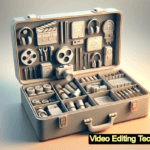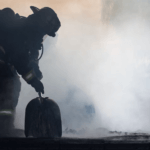Some people believe that firefighting, at the most, is an organized profession that is a few hundred years old. The truth is that the first-ever fire pump belongs to the 3rd century BC. It became a proper profession under the reign of the first Roman Emperor, Augustus.
At the time, ancient Rome had a firefighting department comprising nearly 7,000 paid firefighters. Besides fighting the flames in fire accidents, these brigades were responsible for patrolling the streets and punishing those who violated the fire prevention codes.
Today, this profession is a far cry from its humble origins. According to the US Fire Administration, there are currently 27,139 fire departments registered with the National Fire Department Registry. These brave professionals perform their duty with the help of some crucial and advanced equipment.
What’s even better is that a technological revolution is brewing that may make firefighting a safer and more effective undertaking in the future. In this article, we will discuss firefighting closely to understand how far this profession has come.
Ancient Origins of Firefighting
Since we have already talked about where firefighting began, let’s use this section to discuss the ‘innovative’ origins of ancient firefighting. Catastrophic fires have plagued the US for over four centuries. The development of firefighting, particularly in the northeast part of the country, has set the modern era of this profession into motion.
The first-ever recorded structure fire happened in the colony of Jamestown (1608). The colony was barely a year old when a serious fire threatened to wipe it all out. Historical records document that most of the residents’ lodgings, apparel, and private possessions had been destroyed. People began to believe that it was better to dwell in the wild.
The reason the fire ravaged most of the colony was the lack of advanced equipment. The usual drill was rudimentary at best – firefighters used buckets, ladders, swabs, archaic pumps, and hooks or chains.
Even residents could keep buckets in case of an emergency. The interesting thing is that the number of buckets would differ based on the risk involved – a baker would need three, whereas a brewer needed six. In most cases, the threat to life and property was high.
Industrial Revolution: A Paradigm Shift
During the initial era of firefighting, insurance companies bore no responsibility for the potential fire risks. However, the growing number of instances led to an increased demand for risk management. In the late 17th century, the first official insurance companies for firefighting were established.
Before the Industrial Revolution, fires were mostly hazards for individual families or small colonies. This is because almost everyone lived on dispersed farms and managed woodlots. Since fires were unlikely to spread from one house to another, advanced firefighting equipment and fire departments were unnecessary.
The Industrial Revolution changed the way people confronted fires, among other things. That’s when each district housed a fire department to handle any fire-related accidents.
The departments would have all the required equipment – ladders, pumper engines, hooks, engine houses, etc. By this time, the fire hydrant was much more advanced, with a nozzle for hose attachment.
Cutting-Edge Advancements Shaping the Future
Today, firefighters carry with them fire extinguishers, ropes, multi-purpose hooks, heavy-duty carabiners, and whatnot. Even so, the industry is in the middle of a 360-degree makeover.
Let’s look at some cutting-edge advancements that will shape the future of firefighting.
Fluorine-Free Foam
A white foam-like substance has replaced water in most firefighting endeavors. Especially used for fast-spreading liquid-fuel fires, the Aqueous Film Forming Foam or AFFF is known for its low viscosity. It is made using per- and polyfluoroalkyl substances or PFAS, a complex group of over 12,000 chemicals.
All these chemicals share a strong carbon-fluorine bond that cannot be disintegrated easily. Though the foam is highly effective, it is equally toxic to human health and the environment. According to TorHoerman Law, firefighters developed cancers of the kidneys and testicles after decades of exposure to AFFF.
The situation has come to a point where over 7,000 of them have filed a firefighter foam lawsuit against PFAS manufacturers like 3M. These chemicals have even contaminated several municipalities’ groundwater. They have been banned from production by the end of 2025.
This is why heavy research is ongoing for fluorine-free alternatives that will be as effective against liquid-fuel fires. Non-toxic firefighting foam will ensure that firefighters can perform their duty without compromising their health.
Drones
Also known as unmanned aerial vehicles (UAVs), drones have already been introduced in the firefighting world. The best-ever example would be the tragic fire of Paris’ Notre Dame Cathedral. The robotic helpers acted as eyes in the sky for the brave firefighters.
They provided aerial images of the edifice from all angles, going as far as the hard-to-reach nooks and crannies. Firefighters had a clear picture of the structure and could enter it using safe points (whilst avoiding the high-risk ones).
Furthermore, a thermal radiation-resistant robot called Colossus was equipped with cameras, sensors, and a smoke-extraction fan. It even sprayed water directly at hotspots and rescued wounded people from the scene. If it weren’t for these robotic supporters, the 850-year-old historic structure would have completely collapsed.
Shortly, drone usage in firefighting will increase. This will not only make firefighters’ work easier but will also preserve their safety and well-being.
Thermal Imaging
Thermal imaging cameras are essential tools that can enable firefighters to visualize their plan of attack, monitor the fire’s spread, and locate hotspots. This is not completely novel equipment, as fire departments have been using them for quite some time.
However, only the fire chief was required to carry them until now. In the future, it is expected that all team members will carry one for safety. Then, each member can stay in touch with the others and have greater situational awareness. Even in areas of poor visibility, firefighters can locate victims, entry/exit points, and hotspots.
The profession of firefighting has come a long way, but it is full of inherent risks. In 2022, 96 firefighters lost their lives, out of which 51 performed their duty voluntarily. There were six multiple fatality incidents.
With these technologies, it is believed that the death numbers would go down. Hopefully, firefighting will also become a safe profession in the years to come.










